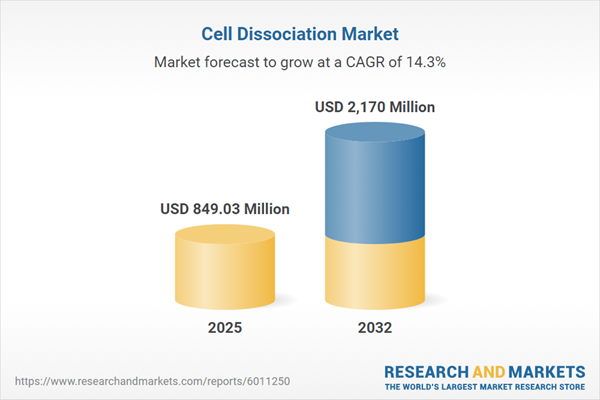Speak directly to the analyst to clarify any post sales queries you may have.
The cell dissociation market is evolving to meet the precise demands of advanced therapeutic and diagnostic workflows. With the rapid adoption of cutting-edge life sciences techniques, organizations require flexible, reliable solutions that efficiently isolate individual cells for analytical and production purposes. This report delivers a focused analysis, supporting executive strategy development and operational optimization in this critical sector.
Market Snapshot: Cell Dissociation Market Size and Growth
The cell dissociation market grew from USD 746.86 million in 2024 to USD 849.03 million in 2025, with a robust compound annual growth rate (CAGR) of 14.30%. Forecasts indicate continued expansion, reaching USD 2.17 billion by 2032. Strong momentum is driven by the surge in both research and clinical cell-based applications, making cell dissociation essential for organizations seeking efficiency and compliance in cellular processing.
Scope & Segmentation of the Cell Dissociation Market
The report provides comprehensive analysis across all core segments and regions, offering in-depth insights for targeted strategy decisions.
- Type: Cell Detachment, Tissue Dissociation
- Product: Instruments (Automated Dissociators, Manual Tissue Grinders), Kits (Multiplex Kits, Single-Use Kits), Reagents (Buffers, Enzymes)
- Tissue Type: Connective, Epithelial, Muscle, Nervous Tissue
- Technology: Chemical (Chelating Agents, Osmotic Agents, Surfactants), Enzymatic (Collagenase, Dispase, DNase, Trypsin), Mechanical (Filtration, Shear, Ultrasonic)
- Application: Cell Therapy (Car-T Manufacturing, Stem Cell Expansion), Cell-Based Research, Clinical Diagnostics (Flow Cytometry, Histopathology), Drug Screening (High-Throughput Screening, Target Validation)
- End User: Academic & Research Institutes, Contract Research Organizations, Hospitals & Diagnostic Centers, Pharmaceutical & Biotech Companies
- Regional Coverage: Americas (United States, Canada, Mexico, Brazil, Argentina, Chile, Colombia, Peru), Europe, Middle East & Africa (United Kingdom, Germany, France, Russia, Italy, Spain, Netherlands, Sweden, Poland, Switzerland, UAE, Saudi Arabia, Qatar, Turkey, Israel, South Africa, Nigeria, Egypt, Kenya), Asia-Pacific (China, India, Japan, Australia, South Korea, Indonesia, Thailand, Malaysia, Singapore, Taiwan)
- Key Companies: Corning Incorporated, Merck KGaA, Becton Dickinson and Company, Bio-Techne Corporation, STEMCELL Group, Thermo Fisher Scientific Inc., and additional sector leaders
Key Takeaways for Senior Decision-Makers
- Cell dissociation is vital in enabling advanced single-cell analysis, supporting growth in genomics, regenerative medicine, and personalized therapies.
- Technological diversification includes automated, chemical, enzymatic, and mechanical solutions, which align workflows to specific cell and tissue types.
- Standardized, closed systems and validated reagent kits are increasingly prioritized for compliance with evolving regulatory frameworks.
- Adoption of modular instruments and single-use consumables addresses operational flexibility and minimizes contamination risks in dynamic research and manufacturing settings.
- Collaborative innovation among developers, clinical teams, and contract research organizations is accelerating the co-development of application-specific kits, enhancing relevance and usability.
Impact of 2025 U.S. Tariff Adjustments on Cell Dissociation Supply Chains
- Revised United States tariff schedules have triggered strategic shifts in procurement, supply diversification, and localized production to offset pricing and availability pressures on enzymes, buffers, and instrument parts.
- Stakeholders are adopting regional partnerships, revising bills of materials, and carrying higher inventory to navigate new trade policy volatility and secure operational continuity.
Methodology & Data Sources
This report integrates primary interviews with stakeholders across the cell dissociation ecosystem, supported by systematic secondary research from scientific literature, regulatory reports, and expert workshops. Comprehensive segmentation matrices and robust data validation processes ensure actionable and accurate insights for your organization.
Why This Report Matters for Executives
- Empowers strategic planning through detailed segmentation, company profiling, and regional opportunity mapping in the cell dissociation market.
- Delivers a clear view of technology adoption trends, competitive innovation, and regulatory impacts shaping operational and investment decisions.
Conclusion
The cell dissociation market is poised for sustained transformation, with strategic innovation, operational agility, and regulatory foresight central to success. This report equips decision-makers with the clarity needed to capitalize on shifting dynamics and ensure resilient, forward-looking strategies.
Additional Product Information:
- Purchase of this report includes 1 year online access with quarterly updates.
- This report can be updated on request. Please contact our Customer Experience team using the Ask a Question widget on our website.
Table of Contents
3. Executive Summary
4. Market Overview
7. Cumulative Impact of Artificial Intelligence 2025
List of Figures
Samples

LOADING...
Companies Mentioned
The key companies profiled in this Cell Dissociation market report include:- Corning Incorporated
- Merck KGaA
- Becton, Dickinson and Company
- Bio-Techne Corporation
- STEMCELL Group
- Thermo Fisher Scientific Inc.
- Abeomics Inc.
- Captivate Bio, LLC
- Cell Signaling Technology, Inc.
- Celprogen Corporation
- Central Drug House. (P) Ltd.
- Genaxxon bioscience GmbH
- HiMedia Laboratories Private Limited
- Innovative Cell Technologies, Inc.
- Neuromics
- Novo Nordisk A/S
- PAN-Biotech GmbH
- REPROCELL Inc.
- RWD Life Science Co., Ltd.
- Sartorius AG
- ScienCell Research Laboratories, Inc.
- Stemmera Inc.
- VitaCyte, LLC
- VWR International, LLC
- Worthington Biochemical Corporation
Table Information
| Report Attribute | Details |
|---|---|
| No. of Pages | 181 |
| Published | October 2025 |
| Forecast Period | 2025 - 2032 |
| Estimated Market Value ( USD | $ 849.03 Million |
| Forecasted Market Value ( USD | $ 2170 Million |
| Compound Annual Growth Rate | 14.3% |
| Regions Covered | Global |
| No. of Companies Mentioned | 26 |









